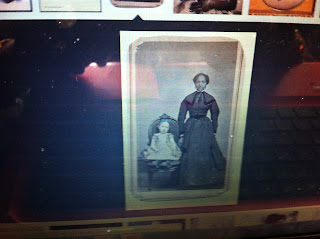BLACK SOCIAL HISTORY The most uncomfortable breastfeeding photo you will see
—-
An African mother and slave, presumably wet-nursing for a white master’s baby while her own child goes without. The image is from The Sociological Cinema files and they are having trouble tracing its true credit. I find this photo incredibly painful – breastfeeding, with all its hormones, bonds, and intimacy, and the transferral of that unwillingly from one’s baby to another’s.
Looking at the photo I was reminded of a description in this piece, which is not about slavery but which is truly beautiful writing from Mona Simpson in The New York Times with “Nannies – Love, Money And Other People’s Children”:
Seeing Michele Asselin’s portraits, I remember the heightened sensitivity of my first months as a parent. The pictures are beautiful and idealized. The women look at the children with love. No one looks frustrated. No one looks bored. No child is having a meltdown. They conjure the dome of tender air that encloses a mother, whose body is coursing with hormones, and a newborn.But these moments of private contentment, with the serenity and depth borrowed from the portraiture legacy of the Madonna and child, do not depict mothers with their infants. The women holding the children are nannies. Part of what’s striking about the pictures is that they position front and center a person who is often left on the editing-room floor when a family’s memories are being assembled. Nannies have told me that their employers crop them out of photographs of their children. On the wall of a West Los Angeles home, I noticed a blown-up photo of a baby in a pretty white dress, held by a pair of hands of a darker color. In her photos, Asselin captures a radiance between caregivers and children, often of different races….. We don’t like to mix love with money. We want love to come as a gift that offers as much pleasure and reward to the giver as to ourselves. No one receiving love wishes to break it down to its component parts, of good sense and feasibility, much less to consider that payment may be necessary to inspire the whole project.
I highly recommend that article, it takes what can be a one note guilt-trip topic and goes somewhere else with it.
UPDATE: As you can see below in the comments the picture has now been identified – this is one of the things I love about writing on the Internet. Pretty much instant knowledge. Harper has the story in a comment below and the mother in the photograph may or may not be an African slave, because she might instead be a paid ‘wet nurse’.
The second thing that has changed since I first wrote this post is my assumption that this photograph would make everyone uncomfortable, as it did with me. The title of my post was, in part, a reference to all the many photographs of mothers breastfeeding their babies that we see where anti-breastfeeding types complain that the pictures are making them uncomfortable, offending them, or turning them on. I thought, now here’s a photo that really does make me uncomfortable and it is because the mother is doing this lovely, nurturing activity with the baby but there is, what I assumed to be given the information I had, a pretty awful backstory. It is the juxtaposition of ‘mother love’ against the cruelty of slavery that makes me feel uncomfortable. But Minna Salami of MsAfropolitan, and a Huffington Post blogger, told me she had quite a different reaction to the photo:
Minna Salami: Does this photo make you feel uncomfortable? I find it strong and compassionate even if poignant. Wondering why you presumed that the African woman’s own child wasn’t being breastfed? Takes away agency..Me: Guess I’m imagining her baby isn’t allowed to be prioritised over this other baby. And it’s missing out on something.Minna Salami: Whether prevented or not, a mother could find ways to protect her children. And surely often would. There was still agency. To me, the photo says love and humanness triumphs despite patriarchy and racism.
This is another thing I love about writing on the Internet. New ways of thinking. Minna Salami makes an excellent point and it is one that was also expressed by ifyspify in the comments below.
Finally, a word to clarify my original post: I wasn’t assuming that the mother in this photo was necessarily not able to also breastfeed her own baby but I was assuming that she would be forced to attend to this baby over her own baby.
PerthMum makes a good point in her comment that breastfeeding supply equals demand and obviously mothers are able to breastfeed twins and other multiples. My opinion on wet-nursing was also influenced by having recently read this article about Europe where Anne Manne says:















































































































































































No comments:
Post a Comment